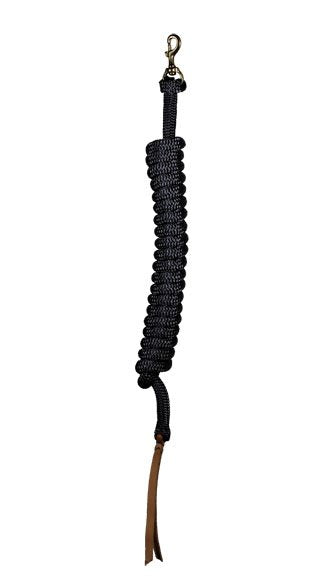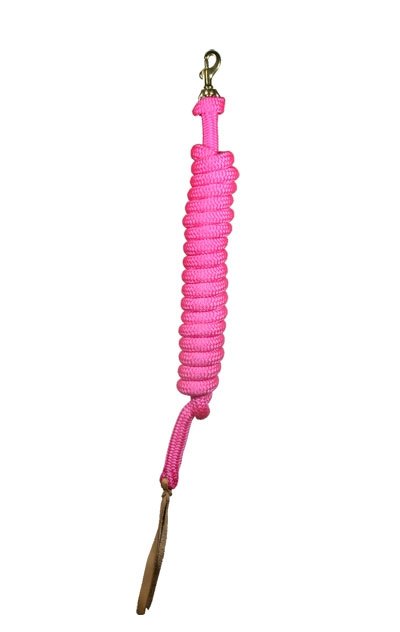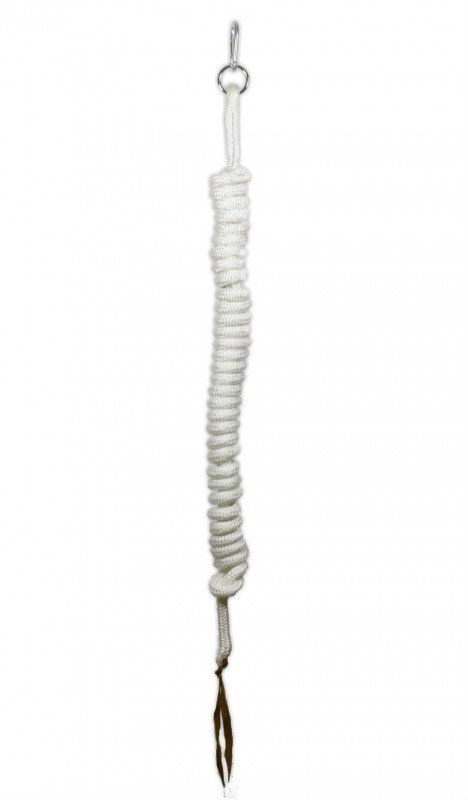
Kies de perfecte leadrope: Welke leadrope past bij jou?
What is a Lead Rope?
A lead rope is a long rope commonly used in horse training. It’s especially useful during groundwork, Natural Horsemanship, and liberty training. The main difference from a standard halter rope? The length! A lead rope is longer, allowing you to easily switch between short and long distances from your horse. With a lead rope, you can lead the horse, ask it to yield to pressure by moving forward, sideways, or backward. Even working in a circle is possible with a standard 12-foot (3.65 meters) lead rope.The material and weight of the lead rope also make it different from a halter rope. Lead ropes are designed to efficiently transmit your signals to your horse. It’s crucial that the weight of the lead rope is just right because after giving an aid, the rope should quickly hang still. This is essential since ropes made from materials that are too light can create “noise” in your communication. By "noise," I mean that your signals won’t come through clearly, as lighter halter ropes significantly delay your timing.
The Right Lead Rope: Materials
**Polyester**A polyester lead rope is durable and lasts a long time. These ropes have the right weight for working with yielding to pressure, such as the Parelli Natural Horsemanship methods. The PRO series lead ropes in our collection are made from polyester and are favored by many professional horse trainers.
**RPET**
If you prefer sustainable choices and want a lead rope that is not only long-lasting but also made from recycled materials, RPET is a great option. It’s similar to the PRO series, made from polyester, and crafted from recycled PET bottles.
**Polypropylene**
Polypropylene is braided similarly to polyester, but it’s lighter in weight, available in many more colors, and absorbs even less water than polyester. Only advantages over polyester? No, polyester lead ropes are more resistant to wear and tear.
**Spun Polyester**
Spun polyester feels very pleasant in the hand, thanks to the softer outer shell, and feels almost like cotton. This has an explanation. Spun polyester is spun like cotton in the rope factory. Spun polyester is widely used in the freestyle method and in DressuurNatuurlijk training.
**Cotton**
Cotton lead ropes are an excellent choice for trainers who work with a natural and soft connection with their horse. These trainers focus less on yielding to pressure, as this lead rope is not heavy enough for that. These lead ropes are light and extremely soft to the touch. You hardly notice you're holding them, allowing you to fully concentrate on your partnership with your horse. Consider, for example, the way Klaus Ferdinand Hempfling trains.
The Right Lead Rope: Length
Considering buying a long lead rope right away? It might seem convenient to be ready all at once. However, the length of the lead rope relates to how far along you and your horse are in training. Lead ropes start at 12 ft, which is about 3.6 meters—an ideal length for beginners and basic training. If you and your horse are already well attuned to each other, and your horse responds well to aids, you’ll gradually increase the distance between you and your horse and transition to a longer lead rope.
Starting with a long lead rope while you're just beginning groundwork can make it difficult to avoid getting tangled in the excess length.
If your communication with your horse is excellent even at a long distance, and you consider yourself highly advanced, you can move on to an 8mm or 10mm thick lead rope. We offer these in the PRO series. These lighter and thinner lead ropes are ideal for more refined communication, especially if you're slowly transitioning towards liberty work.
The Right Lead Rope: Choose Your Clip
Now that you’ve perhaps chosen the ideal lead rope for you and your horse, you might also need to decide between various types of clips. Generally, the larger and heavier the clip, the more pronounced the effect will be. This choice should match your goals and training method.The brass snap is a popular clip for lead ropes. It's strong and has a nice, versatile weight. The twist-lock clip is a choice for those who prefer a little extra weight on their lead rope, giving a clearer and sharper effect.
If you prefer a very soft effect, choose a lead rope with just a loop.
We are proud of our versatile collection and our ability to offer a lead rope for everyone. Still unsure or want to learn more about specific materials, lengths, or clips? Don’t hesitate to contact us. We are here to help and provide advice.
























